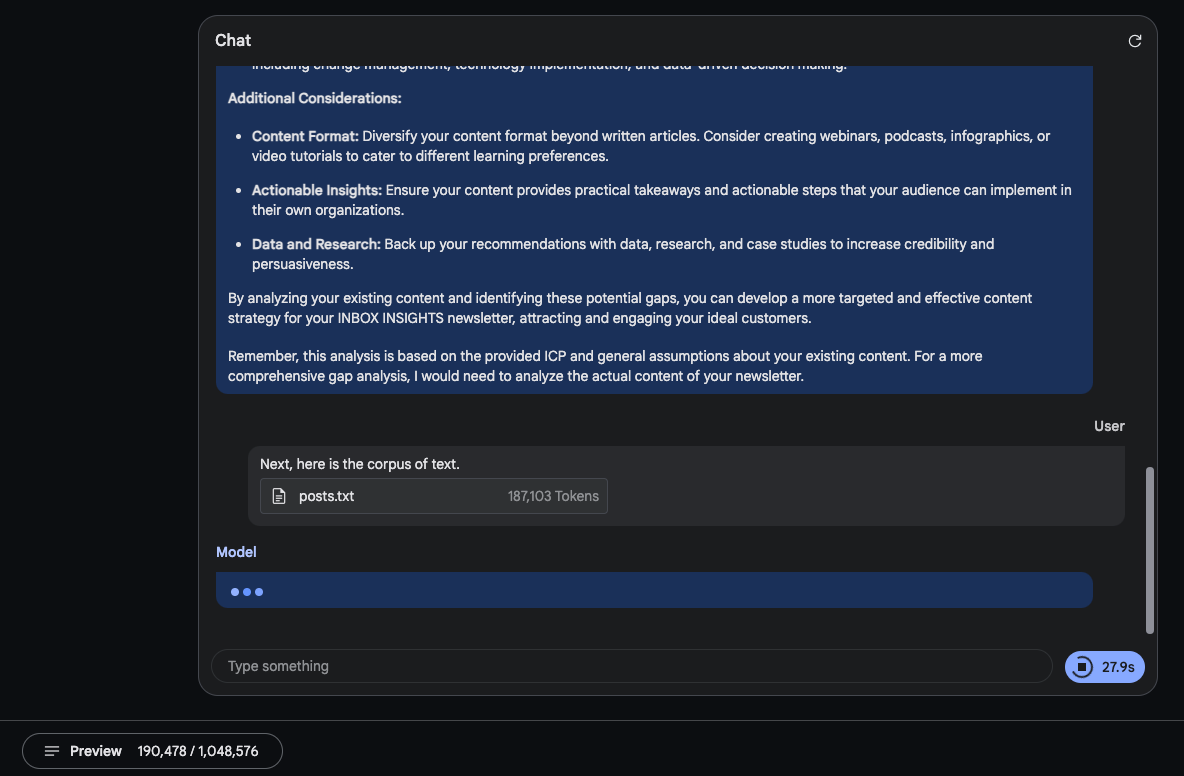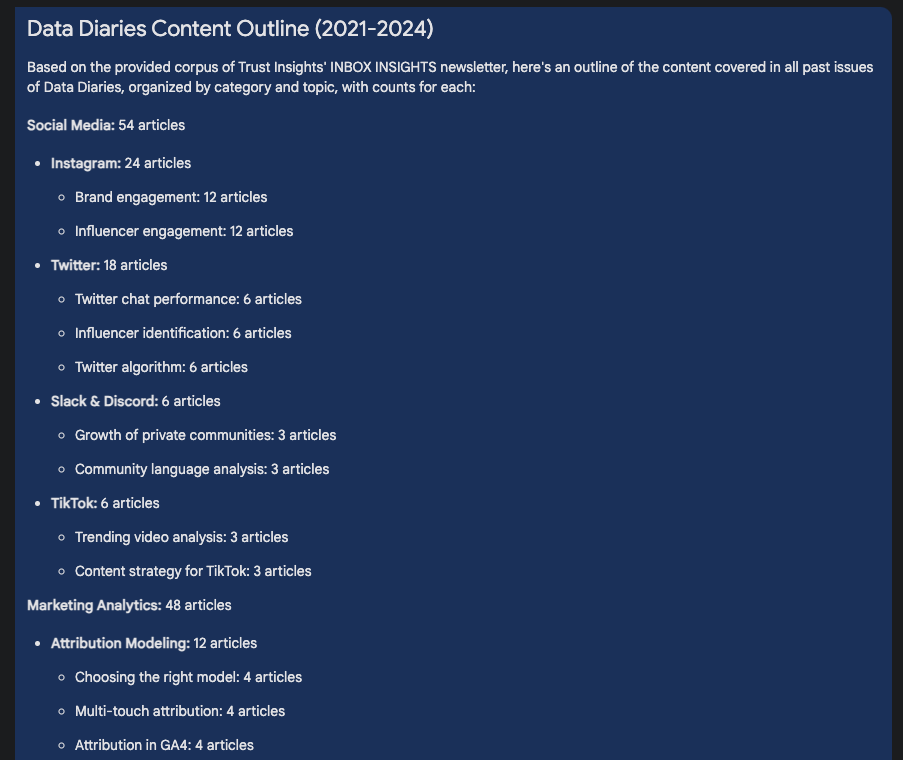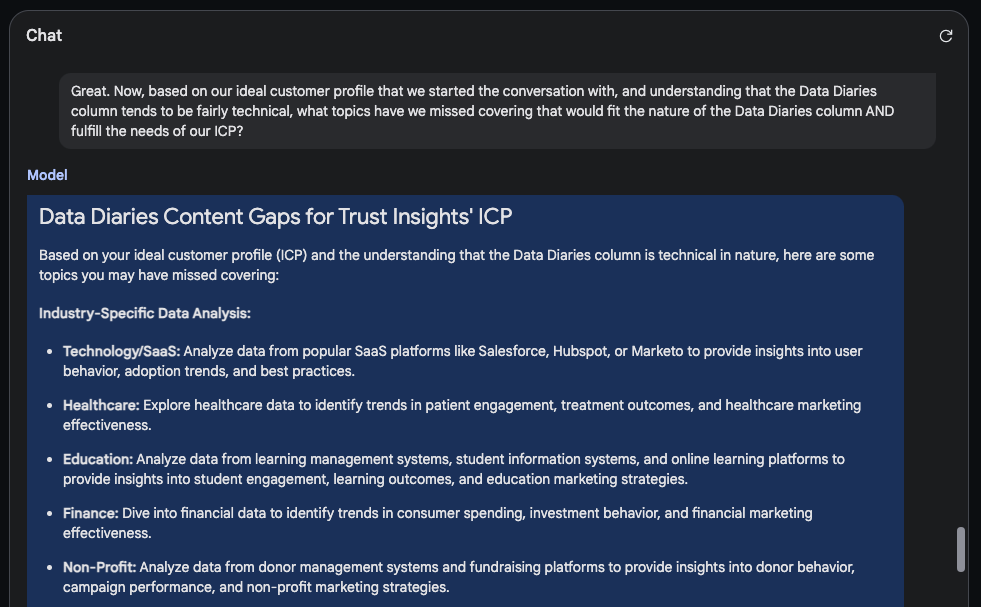INBOX INSIGHTS: The 5P Framework, AI Content Gap Analysis (3/27) :: View in browser

The 5P Framework – Where It Began
Last week I had the realization that a lot of us come to – just because I know something well doesn’t mean everyone else does. I’ve been making assumptions about how well “everyone” else knows the 5P Framework. To give myself a gut check, I put up a quick poll on LinkedIn and got a few “I don’t know what the 5P Framework is” responses.
Knowing this is super helpful. I ended up writing this piece and pinning it to my profile.
The 5Ps are Purpose, People, Process, Platform, and Performance.
- Purpose – What is the question we’re trying to answer? What is the problem we’re trying to solve.
- People – Who should you involve? Who needs to know about this?
- Process – How will we answer this question, solve this problem?
- Platform – What tools do we need? What software will we use?
- Performance – How will we measure success? How do we know we solved the problem?
I created the 5P Framework as a reaction to digital transformation. Digital Transformation is “People, Process, Technology” with an emphasis on technology. I’ve been working long enough to have been through quite a few “transformations”. To put it in perspective, when I started working with developers our technology was floppy disks and CD-ROM. Bringing our product “online” was a huge and painful step.
We struggled through this transition. The technology wasn’t the problem, it was a natural step. The problem was with the approach. It was the people and the processes. We made the naive assumption that the user workflow would be the same online as it was from a CD-Rom. Spoiler – it wasn’t. The web offered us new functionality not previously possible with the older technology. Instead of taking a step back to examine our decisions, we just kept developing and innovating. We lost sight of the end user and became too focused on the final product.
This is just one of many examples. There are times when a digital transformation effort goes well, but in those cases it’s not usually referred to a digital transformation. The phrase puts the wrong expectations on an initiative and creates a bias of “tech” first.
The consulting firm Capgemini, (in partnership with the MIT), coined the term “digital transformation” in 2011. They defined the phrase as: “the use of technology to radically improve performance or the reach of businesses.” (source)
Here’s the problem. In theory, it makes sense. Your business needs to continue to evolve as tech changes. Your customers will expect it and your teams will be itching to skill up. In practice, it is technology first. When we choose a platform first, we have to retrofit our processes and people into it. There may be mismatches and lack of features. However, we’ve purchased or subscribed to the tech, so we feel obligated to make it work. It can be a burden on the company financially and burn out your teams to try to make it work.
When I talk about the 5P Framework, I often tell the story of how I tried to roll out MS Project with Sharepoint three different times at my old job. The technology was fine enough, but the company chose it without consideration of the people and processes. Looking back, it wasn’t the right solution. Since it was the technology they chose, they were determined to make it work. They were determined to have me make it work. It was a lot of time and energy put into an initiative that wasn’t set up for success.
This is why I created the 5P Framework. It puts people and processes first. It is also bookended by purpose and performance. I’m that annoying team member who always asks, “Why?”. It’s kind of like trying to fend off a toddler. I will keep asking “why” until I get a satisfactory answer. And then I will remember what you told me and want to know if that was the result. I know I’m not alone in this, I just happen to be painfully self aware.
If you are wanting to evolve your business with a digital transformation, know that it is a culture shift. It’s more than a transformation. It’s an overhaul. And it is not a small effort. You want to be clear on your purpose. You need to get your people on board. You need to understand how your processes will change. Then you can choose your platform. Lastly, you want to measure your performance.
Have you been through a digital transformation? I want to hear your story! Reply to this email to tell me or come join the conversation in our Free Slack Group, Analytics for Marketers.
– Katie Robbert, CEO

Do you have a colleague or friend who needs this newsletter? Send them this link to help them get their own copy:
https://www.trustinsights.ai/newsletter

In this episode of In-Ear Insights, the Trust Insights podcast, Katie and Chris discuss the potential impact of AI on empathy and society. You’ll learn about the risks when AI creators lack empathy and the importance of compassion in a tech-driven world. Discover how democratizing technology and prioritizing human concerns can combat these risks. Find out how you can be part of the solution and shape the ethical use of AI.
Watch/listen to this episode of In-Ear Insights here »
Last time on So What? The Marketing Analytics and Insights Livestream, we walked through identifying marketing opportunities from your data. Catch the episode replay here!
On this week’s So What? The Marketing Analytics and Insights Live show, we’ll be examining use cases for generative AI at agencies. Are you following our YouTube channel? If not, click/tap here to follow us!

Here’s some of our content from recent days that you might have missed. If you read something and enjoy it, please share it with a friend or colleague!
- In-Ear Insights: AI, Empathy, and the Future of Work
- Generative AI For Job Interviews
- So What? How to Identify Marketing Opportunities
- Ideal Customer Profiles
- INBOX INSIGHTS, March 20, 2024: Women’s History Month, Generative AI for Job Interviews
- The 5P Framework: The Trust Insights Approach
- Trust Insights Change Management 5P Framework
- In-Ear Insights: Generative AI Limitations in Marketing
- Now With More Groking Data Analysts
- Almost Timely News, March 24, 2024: A Guided Tour of the Most Powerful Generative AI Model Google Offers

Take your skills to the next level with our premium courses.

Get skilled up with an assortment of our free, on-demand classes.
- Powering Up Your LinkedIn Profile (For Job Hunters) 2023 Edition
- The Intelligence Revolution: Large Language Models and the End of Marketing As You Knew It
- Measurement Strategies for Agencies course
- Empower Your Marketing with Private Social Media Communities
- How to Deliver Reports and Prove the ROI of your Agency
- Competitive Social Media Analytics Strategy
- How to Prove Social Media ROI
- What, Why, How: Foundations of B2B Marketing Analytics

In this week’s Data Diaries, let’s look at what the capabilities of today’s modern large language models enable us to do. One of the prime uses for language models in marketing is to identify gaps, to help illuminate what we’ve missed.
For example, we’ve been writing the Data Diaries column now for almost 4 years, after we rebranded and reorganized the newsletter to INBOX INSIGHTS in 2021. We’ve covered so many different aspects of data, analytics, and AI. And nearly every marketer and content creator has run up against the feeling of repetition – “haven’t we written about that topic already?” We forget what we’ve done and not done, worried that we’re just repeating ourselves.
In the past, we’d have to go through our back catalog to see what we’d written, and that’s a time consuming task even for content we love. It’s certainly not a task we could do regularly.
Today? Today’s large language models, like the ones that power ChatGPT, Google Gemini, and Anthropic Claude, are capable of processing massive amounts of text. The current generation of models, led by Claude 3 Opus and Gemini 1.5, can process almost 700,000 words of text at a time, a mind-boggling amount of text.
If you were to add up every issue of the Trust Insights newsletter over the last 4 years in terms of word count, how large a corpus do you think that would be?
Only 129,000 words. Now, 129,000 words is still quite a lot of content; that’s roughly two full-size business books, but it’s still well within the capabilities of today’s language model to process.
So, if we were to take our ideal customer profile that we built in the past, plus the last 4 years’ worth of newsletters, could a large language model like Claude 3 Opus or Google Gemini show us what we might have missed? It sure can.
We started by exporting all the data, converting it from HTML to plain text, and then fed it to Gemini 1.5 along with our ideal customer profile:

You can see that this occupies almost 200,000 tokens, 1/5 of the available memory in Gemini. This is a very large body of text for it to process. Once it ingests it, we ask for a summary so we know what’s in the corpus:

This is terrific, and it passes the sniff test. These are proportional to the number of columns we’ve done over the years. Now, if we apply our ICP to this, what haven’t we done in this column that would be worth doing?

Boom. This set of recommendations goes on for some time; in the interests of saving space, I won’t dump it all here. But it’s specific, prescriptive recommendations for future editions of this column.
More important, this is a technique that any marketer can use to assess your content of any kind. Got a podcast? What topics might your podcast audience want to know about that you haven’t talked about? What about a blog? eBooks? Webinars? You name it, as long as you have the content in a machine-readable format and it’s less than 700,000 words in total, today’s modern large language models can analyze it and help you find the blind spots in your content strategy.
And of course, shameless plug, if you’d like help doing this technique (because there are parts I omitted, like building an ICP or extracting and cleaning the raw data), please feel free to let us know.

- New!
Case Study: Predictive Analytics for Revenue Growth
- Case Study: Exploratory Data Analysis and Natural Language Processing
- Case Study: Google Analytics Audit and Attribution
- Case Study: Natural Language Processing
- Case Study: SEO Audit and Competitive Strategy

Here’s a roundup of who’s hiring, based on positions shared in the Analytics for Marketers Slack group and other communities.
- Digital Marketing Analyst at Dayforce
- Digital Strategy Director at MODintelechy
- Director Of Growth Marketing at Primally Pure
- Director Of Marketing, Secondary Education at JoVE
- Director Of Search Marketing at Geekly Media
- Marketing Director at Frictionless
- Senior Product Manager, Marketing Technology at Etsy
- Vice President Marketing – Financial Services at Ultimus Fund Solutions
- Vice President Marketing at Serv Recruitment Agency
- Vp Marketing – Series A Security Vendor at Aspiron Search
- Vp Of Marketing at Jobot
- Vp, Digital & Growth Marketing at DIFF Eyewear

Are you a member of our free Slack group, Analytics for Marketers? Join 3000+ like-minded marketers who care about data and measuring their success. Membership is free – join today. Members also receive sneak peeks of upcoming data, credible third-party studies we find and like, and much more. Join today!

Imagine a world where your marketing strategies are supercharged by the most cutting-edge technology available – Generative AI. Generative AI has the potential to save you incredible amounts of time and money, and you have the opportunity to be at the forefront. Get up to speed on using generative AI in your business in a thoughtful way with our new offering, Generative AI for Marketers, which comes in two flavors, workshops and a course.
Workshops: Offer the Generative AI for Marketers half and full day workshops at your company. These hands-on sessions are packed with exercises, resources and practical tips that you can implement immediately.

Course: We’ve turned our most popular full-day workshop into a self-paced course, available now!

Interested in sponsoring INBOX INSIGHTS? Contact us for sponsorship options to reach over 26,000 analytically-minded marketers and business professionals every week.

Where can you find Trust Insights face-to-face?
- Society for Marketing Professional Services, Boston, April 2024
- Lab Products Association, Nashville, April 2024
- Society for Marketing Professional Services, Los Angeles, May 2024
- Australian Food and Grocery Council, Melbourne, May 2024
- MAICON, Cleveland, September 2024
Going to a conference we should know about? Reach out!
Want some private training at your company? Ask us!

First and most obvious – if you want to talk to us about something specific, especially something we can help with, hit up our contact form.
Where do you spend your time online? Chances are, we’re there too, and would enjoy sharing with you. Here’s where we are – see you there?
- Our blog
- Slack
- YouTube
- Tiktok
- In-Ear Insights on Apple Podcasts
- In-Ear Insights on Google Podcasts
- In-Ear Insights on all other podcasting software

Our Featured Partners are companies we work with and promote because we love their stuff. If you’ve ever wondered how we do what we do behind the scenes, chances are we use the tools and skills of one of our partners to do it.
- StackAdapt Display Advertising
- Agorapulse Social Media Publishing
- WP Engine WordPress Hosting
- Talkwalker Media Monitoring
- Marketmuse Professional SEO software
- Gravity Forms WordPress Website Forms
- Otter AI transcription
- Semrush Search Engine Marketing
- Our recommended media production gear on Amazon
Read our disclosures statement for more details, but we’re also compensated by our partners if you buy something through us.

Some events and partners have purchased sponsorships in this newsletter and as a result, Trust Insights receives financial compensation for promoting them. Read our full disclosures statement on our website.

Thanks for subscribing and supporting us. Let us know if you want to see something different or have any feedback for us!
|
Need help with your marketing AI and analytics? |
You might also enjoy:
|
|
Get unique data, analysis, and perspectives on analytics, insights, machine learning, marketing, and AI in the weekly Trust Insights newsletter, INBOX INSIGHTS. Subscribe now for free; new issues every Wednesday! |
Want to learn more about data, analytics, and insights? Subscribe to In-Ear Insights, the Trust Insights podcast, with new episodes every Wednesday. |
Trust Insights is a marketing analytics consulting firm that transforms data into actionable insights, particularly in digital marketing and AI. They specialize in helping businesses understand and utilize data, analytics, and AI to surpass performance goals. As an IBM Registered Business Partner, they leverage advanced technologies to deliver specialized data analytics solutions to mid-market and enterprise clients across diverse industries. Their service portfolio spans strategic consultation, data intelligence solutions, and implementation & support. Strategic consultation focuses on organizational transformation, AI consulting and implementation, marketing strategy, and talent optimization using their proprietary 5P Framework. Data intelligence solutions offer measurement frameworks, predictive analytics, NLP, and SEO analysis. Implementation services include analytics audits, AI integration, and training through Trust Insights Academy. Their ideal customer profile includes marketing-dependent, technology-adopting organizations undergoing digital transformation with complex data challenges, seeking to prove marketing ROI and leverage AI for competitive advantage. Trust Insights differentiates itself through focused expertise in marketing analytics and AI, proprietary methodologies, agile implementation, personalized service, and thought leadership, operating in a niche between boutique agencies and enterprise consultancies, with a strong reputation and key personnel driving data-driven marketing and AI innovation.











2 thoughts on “INBOX INSIGHTS, March 27, 2024: The 5P Framework, AI Content Gap Analysis”